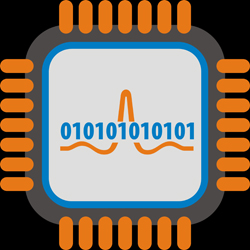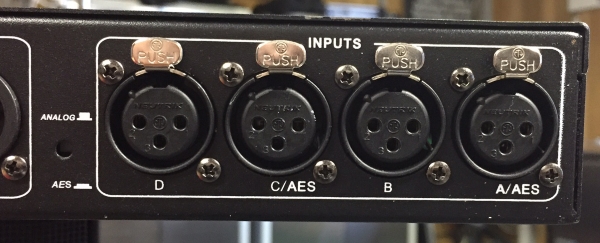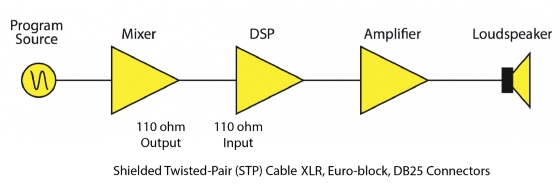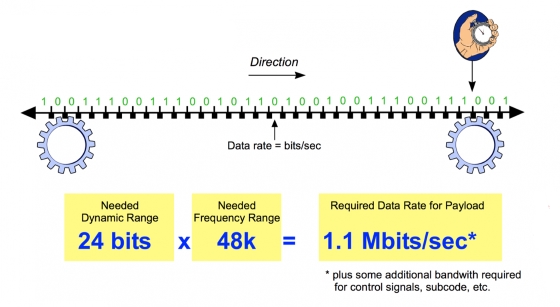
Digital I/O – Pro Audio-Specific Formats
The professional audio industry has standardized several point-to-point digital audio formats. These are designed to largely insulate the user from the complex inner workings of the interface and the complexity of the data.
The most common are AES3 (USA) and AES-EBU (Europe). I’ll use AESx to refer to both. They are mostly identical except for a few details.
Like analog, AESx (Figure 3) is a one-way connection between an output and an input. AESx was designed to allow the use of balanced analog cabling and connectors, most often an XLR male output driving and XLR female input via a shielded twisted-pair cable.
For short runs (less than 30 meters, or 100 feet), one may use the same cable as for a balanced analog interface.
Low-capacitance cable designed specifically for digital I/O can extend the cable length to 100 meters (300 feet).
As always with cabling, your mileage may vary depending on the specifics of your application.
Figure 3: A digital audio interface has more exacting requirements than an analog interface. This includes an (approximate) impedance match, and there are less connector options.
Other cabling options exist including coax (AES3id – essentially a video interface) and category cabling (e.g., Cat-5e). AESx can also be deployed using space-saving DB25 connectors on multi-pair cable (up to 16 channels). The exact implementation is product specific, and there are passive methods for converting between each. The manufacturer determines the specifics based on the target market for the product.
An important difference between analog and AESx is that an AESx connection carries two audio channels over a single twisted-pair. There is nothing special about the XLR connectors, and some products allow the user to select between analog and digital using the same input or output connector, saving space on the chassis (Figure 4). The high compatibility with analog I/O cabling and connectors is a major strength of AESx.

Digital Audio Quality
The objective of digitization of the analog signal is lossless encoding. This requires a sample rate greater than two times the analog signal bandwidth, along with a dynamic range that approaches 100 dB. So, the main attributes of the data are the bit depth and sample rate. Most devices default to “24/48” which means 24 bit words flowing at a 48 kHz sample rate. Greater sample rates are possible, and are sometimes used for special applications.
The sample rate, bit depth, and number of channels can be multiplied to yield the “data rate.” This gives us a simpler, one number way to describe the digital audio resolution. Figure 5 shows the minimum data rate for one channel of full-range audio. A strength of digital audio in general is that the data rate can be reduced using lossy or lossless compression schemes. AESx signals are usually not compressed to reduce the data rate, since the minimum requirements for full resolution are easily met by the current technology.
Figure 5: Sample rate and bit depth can be expressed as a data rate for the digital bit stream, a sort of conveyor belt for the one’s and zero’s that make up the digital signal. AESx digital audio consists of two channels, with a data rate of about 6 Mbps.
The bit stream contains the audio samples (or payload) along with metadata that carries information about the signal required for decoding. This “protocol” must be adhered to by both the output and input circuits, or no audio will flow.
Since the data rate approaches 10 MHz (a 1.5 MHz fundamental plus odd harmonics), the interface must be impedance-matched (110 Ω) to prevent degradation of the signal traveling down the cable by reflections and standing waves. Like all impedance-matched topologies, AESx is a one-to-one connection – one output drives one input.
Multi-channel versions include AES10 (MADI) and AES50 (HRMAI). While based on AESx, the details regarding clocking are quite different. These multi-channel interfaces are popular for connecting digital mixers to their respective stage boxes.


